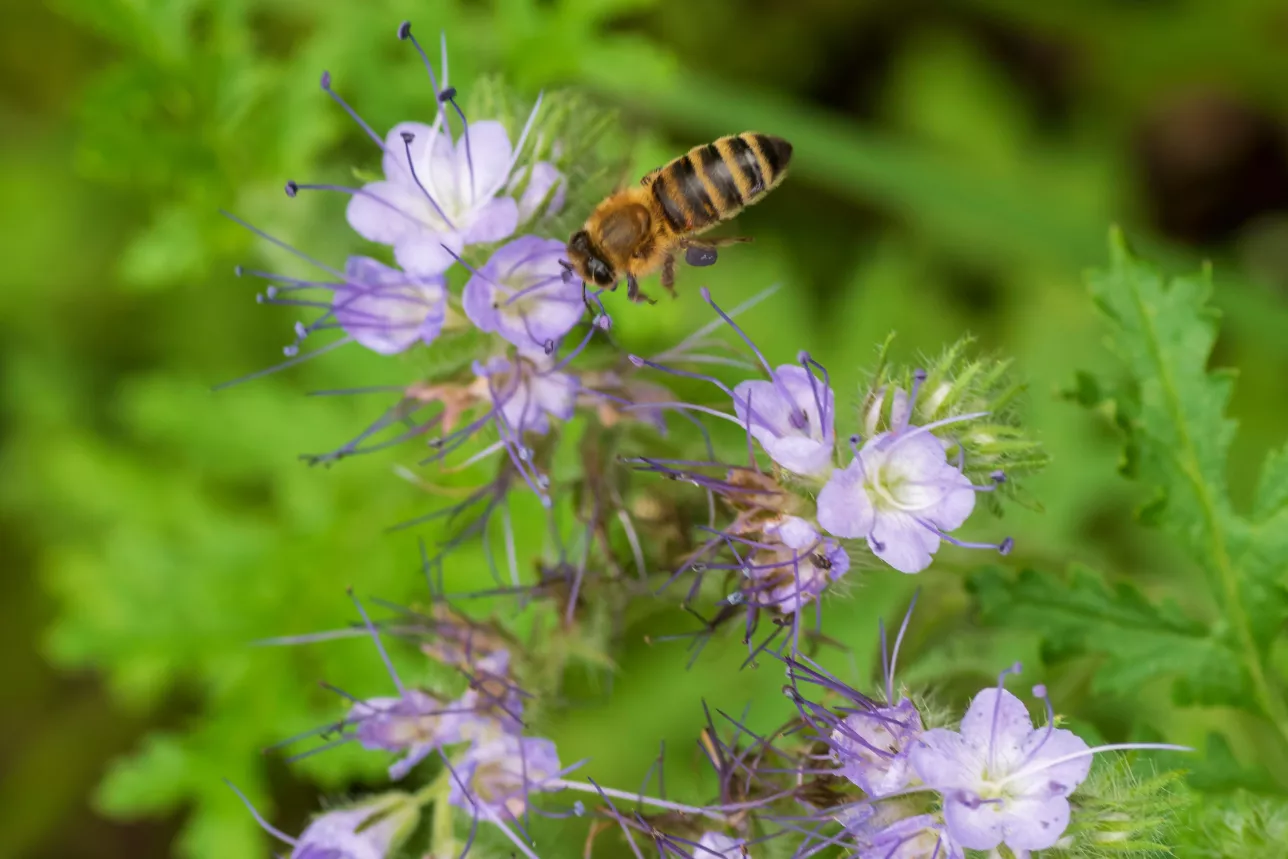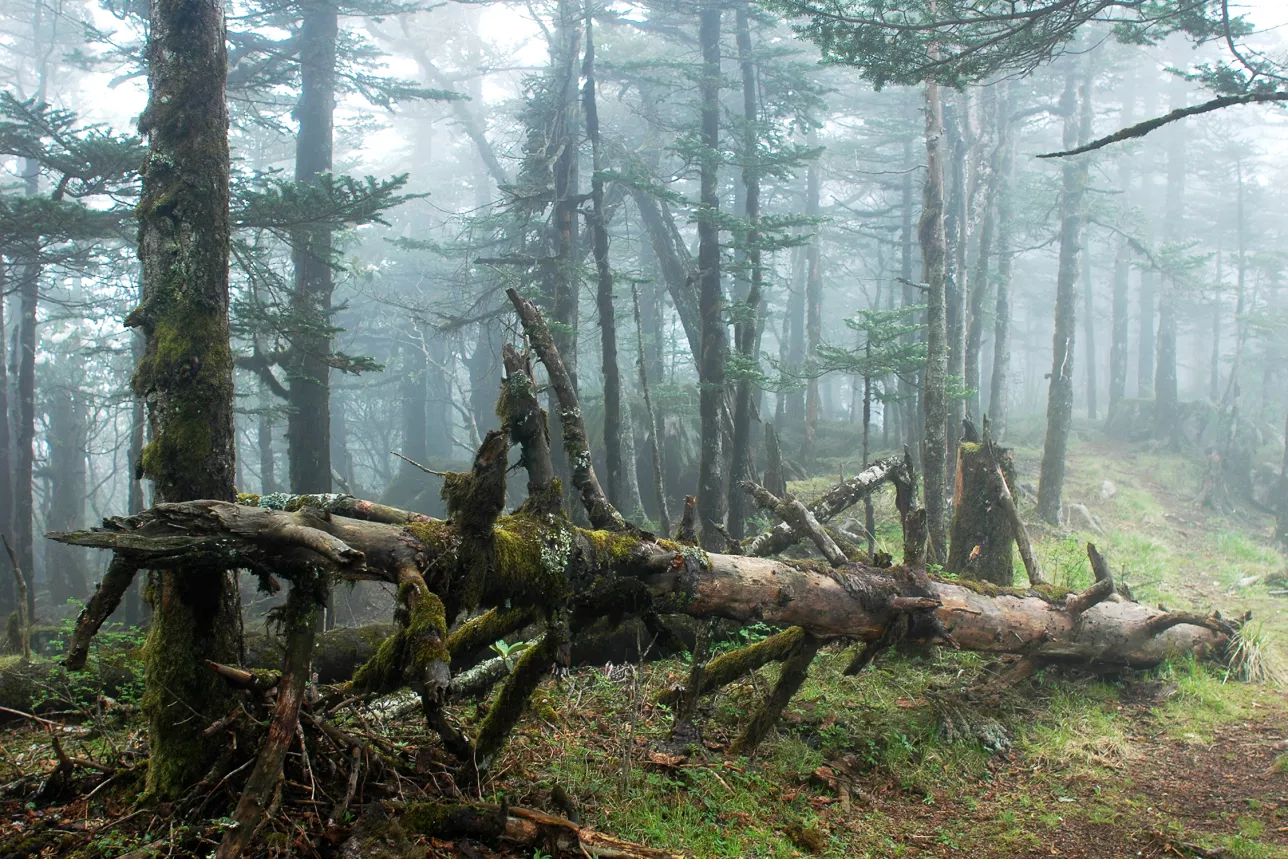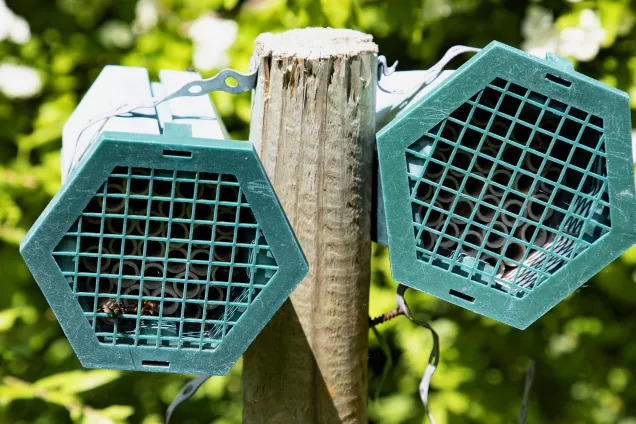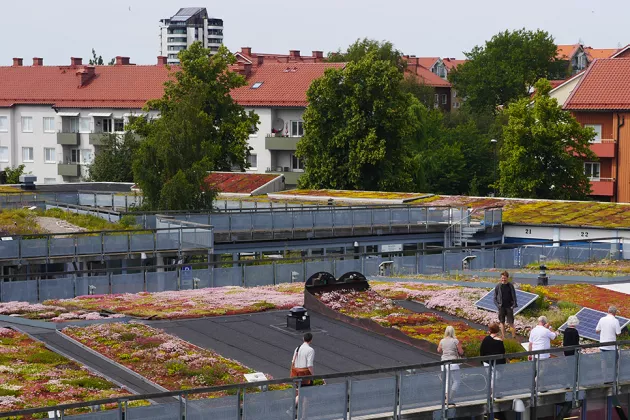Flowers that benefit both bees and biodiversity

An increasing number of people want to help bees and other pollinators by growing flowers that are rich in pollen and nectar. But which flowers are the most beneficial?
If the point is to aid threatened bee species and biodiversity, then a variety of native plants is the way to go. If you are a farmer, with large areas of insect-pollinated crops, it might be easiest to aim for a few species of flower that have lots of nectar and pollen instead.
Lina Herbertsson and Maj Rundlöf conduct research on pollination and biodiversity at Lund University. More knowledge and measures are required: According to the statistics, as many as one in three wild bee species is under threat, and the situation for other pollinating insects is almost as bad.
As the ominous numbers have worsened, the public’s enthusiasm for bees, butterflies, hover flies, beetles and other pollinating insects has taken off. People often get in touch with both researchers with questions or experiences they wish to share. The researchers appreciate the interest. At the same time, rather a lot of misunderstandings have emerged, they note.
“Take for example meadow flowers. On many planned meadows, species have been sown that absolutely do not belong in a traditional meadow,” says Lina Herbertsson.
There is a certain amount of confusion around language, she acknowledges.
“When we biologists talk about meadows, we are not referring to a flower-rich place in general, but rather to the increasingly rare hay meadows, which are unique in their diversity of species and therefore important for many threatened animal and plant species.
The reason for the confusion could be that many seed suppliers – who you might expect to know the terminology – wrongly market their ready-mixed seed assortments as meadow flowers. The little bag that customers receive often contains other species that do not belong in a meadow at all. They may include ornamental plants or grassy weeds from abroad.
Along with other experts, Maj Rundlöf and Lina Herbertsson have called for stricter rules, since at worst, mislabelling can lead to non-native species being spread in the wild. Seed packets in Sweden should include the seeds’ origin as well as the content, they argue.
Flowering headlands...
Their advice is to begin by thinking about why you want to grow pollinator-friendly plants: to increase yields, get closer to pollinating insects in one’s garden or improve biodiversity? There may be conflicts here, say researchers.

If the purpose it to increase yields from insect-pollinated crops, the task is relatively simple: make room for nectar and pollen-rich plants that bloom when the crops are not in bloom. If the insects are served food throughout the season, it increases the chances of the creatures surviving and being able to help with the pollination of crops for years to come.
In recent years, flowering headlands at the edge of fields have become an increasingly common sight, thanks to various initiatives. The hoped-for outcome is the same: attracting insects that can pollinate agricultural crops on the fields, such as rapeseed, clover seeds and broad beans.
The term “melliferous plants” is often used in such contexts. They attract pollinators and it is common for honeybees to flock to these nectar and pollen-rich plants.
“Honey bees might not be the most effective pollinators per visit, but they often come in large numbers, looking for pollen from many different flowering plant species,” says Maj Rundlöf.
In flowerbeds for example, you can throw out seeds from beautiful grassy weeds such as cornflowers and long-headed poppies.
Examples of common melliferous plants that are simple to grow from seed and able to grow on arable fields are blue tansy, various species of clover, buckwheat, birds-foot trefoil, yellow melilot and chicory.
... or a buzzing meadow?
Lina Herbertsson and Maj Rundlöf welcome the various flower-promoting efforts. But they would also like to see a renaissance for traditional hay meadows. Because it is in fact this kind of habitat that provides the greatest cumulative benefit for nature, say the researchers.

Hay meadows were where farmers harvested hay for their animals in late summer. Today, only a tiny proportion of those meadows remain. Instead, animal food is produced on fertilised, species-poor fields. Good for people, perhaps, but not for biodiversity.
On meadows, lots of plant species co-exist, and diversity of plants brings diversity of insects. The entire spectrum of pollinating insects, including threatened species, can be found buzzing around.
“A hay meadow has such a diverse range of native plants that there is no need to think about exactly what plants there needs to be more of. Pollinators simply have a good life there whatever you do,” says Lina Herbertsson.
Many of the 300 species of bees found in Sweden are picky when it comes to food, which means that they only collect pollen from one or a few closely related plant species.
Many Swedish bee species have names that reveal their preferred plants or favoured habitat.

The diversity of flora in meadows is not just crucially important as a source of pollen and nectar, but also as a nursery for lots of insects. Butterflies lay their eggs on the underside of leaves, which then serve as food for larvae before they become pupae and eventually fully-grown butterflies. Many species are extremely specialised in terms of their host plants. One such example is the rare Alcon Blue, which in Sweden lays its eggs only on marsh gentian.
Fruit and berry bushes also benefit from diversity
It is also well worth remembering that solitary bees and bumble bees are important pollinators of plants that we grow.
“For example, there are long-tongued bumble bees that are particularly well-suited to pollinating red clover and several species of solitary bees like to visit apple blossom,” explains Maj Rundlöf.
In addition, different species fly at different points between spring and autumn, and in different weather conditions. If there are lots of species, between them they are able to pollinate plants that bloom at different stages of the growing season, regardless of whether it is dry and hot or cool and damp.
“Put simply, we have more to gain from preserving the diversity of pollinators than from allowing it to be lost,” says Maj Rundlöf.
“We must not forget that we all have a moral responsibility to protect threatened species. Sweden has signed the Convention on Biological Diversity and as such has acknowledged that biodiversity has an inherent value.
More from poor soil
Would you like to create your own meadow? First of all, it is a good thing if the soil is poor, since this increases the potential for diversity.

For a gardening enthusiast, this might come as a surprise. The usual advice is to add organic material from time to time, in order to increase the nitrogen levels in soil, and suddenly in this case you do the opposite!
Do meadow flowers say “no thanks” to nitrogen? What is the explanation?
“Yes and no. Plants generally thrive on nutrients if they don’t have to compete for space. But if the soil is rich in nitrogen, a small number of fast-growing species such as broadleaved grasses, nettles and cow parsley spread. Meadow flowers are particularly bad at competing and as a result have no hope if the nitrogen levels are too high,” explains Lina Herbertsson.
All plants need nutrients, but they also have different strategies for making use of them. The fact is that many species of flower in Sweden and Europe are adapted to nitrogen-poor conditions, and are only able to grow at a certain pace, regardless of how much nutrition they get.
From grass to meadow – how it is done
So, if you have nutrient-poor soil and there are already flowers in your lawn – congratulations! All that actually needs to be done is to scythe or mow the vegetation once a year, in late summer when most flowers have finished flowering and gone to seed. The cut vegetation should be left in situ and allowed to dry so that the plants have time to release their seeds.
However, within a few days it is time to remove the cuttings so that no nutrients are added and no new growth is suffocated. Turn the dried, cut vegetation – the hay – a few times so that the seeds fall out.
Municipalities, county boards, the Church of Sweden, companies and other large landowners have great opportunities to restore and tend to old hay meadows.
If the original conditions include nutrient-rich soil, it may be necessary to lower nutrient levels, which can be done by removing the topsoil and adding sand or gravel. Later, you can take some hay from a recently cut meadow or collect local seeds to hurry along the establishment of meadow plants.
“I usually collect seeds when I’m out cycling.” You often find meadow-like vegetation lining old roads, plants such as bluebells, sticky catchfly and red clover. It is important not to collect protected species, and to take care not to spread invasive species such as lupins,” says Lina Herbertsson.
Cornflower, long-headed poppies, white clover and other plants that want to grow
Or you might choose to live with the nutrient rich soil that you are tending. In that case, you should at least choose native species,” Lina Herbertsson believes.
In flowerbeds for example, you can throw out seeds from beautiful grassy weeds such as cornflowers and long-headed poppies. It turns out a lot nicer than it sounds,” Lina Herbertsson asserts.
It is not just pollinators that survive on these plants, it is also larvae, aphids, spiders, moths and lots of other small creatures.
Admittedly, the name grassy weed does have a negative ring to it, especially for those who have battled with perennial weeds. They should perhaps be called pioneer plants instead, since they are good at growing on a newly ploughed field, but are out-competed as other plants grow up. The fact is that many so-called grassy weeds have declined drastically, some are even threatened with extinction. Examples include corncockle and greater yellow rattle.
Or leave a patch of the lawn un-mowed and see what comes up. Dandelions, brown wort and white clover are examples of plants that might have the chance to flower if the lawnmower stays in the shed until late summer.
It is not just pollinators that survive on these plants, it is also larvae, aphids, spiders, moths and lots of other small creatures. If the plants are native, there is likely to be more fauna.
While the researchers hope that more people invite wild plants into their gardens, they also underline the importance of the garden as a place for recreation and where people’s own desires are allowed to take the lead.
In their own gardens, wild plants live alongside cultivated and imported garden plants such as snowdrops and big bloom roses. Filled roses rarely produce pollen and nectar and are therefore of no use to pollen and nectar consuming insects, but they do not do any harm either.
Meadows were born in sparse forests
Meadows and pastures are of course manmade creations and have only been around for a few thousand years. Did meadow flowers have a difficult existence before humans became farmers? Not at all.
After the last ice age, Sweden was first dominated by a tundra that was gradually covered by more and more forest. The landscape was vastly different to today’s. Long-extinct giant plant eaters such as bison and giant deer – known as megaherbivores – grazed open ground and later the advancing forest.
On grazed or naturally-open ground, and in clearings between trees, the sunlight found its way through to basically the same flowers that would later find habitats on hay-meadows and natural pastures.

Wetlands and floodplains were also more common,, ensuring a lack of trees and sparse forest: the large trees survived while smaller ones went under. Elsewhere, fires thinned the forests, benefitting meadow plants whose seeds survived and had the chance to grow up in new, sunlit areas. Dead wood lay where it fell and became home to insects and other animals.
Arable lands needed for food
The arrival of humans changed the landscape. When our forefathers became farmers, the landscape became a patchwork of meadows, grazed pastures and fields full of flowering weeds and cereals. The hay meadows provided winter food for the animals, which in turn provided fertiliser for the fields and energy-rich foods for people, both directly and through the crops on the fields. The pollinators thrived in that environment too, since there were plenty of flowers in the meadows, pastures and fields.
Today, as we know, things are different. As has been mentioned, forests and fields are highly productive but lack biodiversity.
Yet we cannot go back to the society that existed 150 years ago, Lina Herbertsson underlines.
We need efficient food production. Farmers need the land for crops and as gardeners we rarely have the opportunity to offer larger areas.”
Meadows for experiences and relaxation
Hay meadows should perhaps be seen as recreational environments rather than productive environments, Lina Herbertsson suggests.
“Municipalities, county boards, the Church of Sweden, companies and other large landowners have great opportunities to restore and tend to old hay meadows, sow meadow plants in parks, and choose native perennials and trees when planning recreational environments. We need to utilise new ways of thinking, and I think we have good opportunities to do so.

Building a home for bees
While honeybees have their homes secured thanks to a growing number of beekeepers, the housing situation for solitary bees is becoming increasingly difficult. Wildlife has been cleared out of the modern agricultural and urban landscape. There are plenty of tips online on how to help, but what works?
“Bee hotels of the kind you can buy in the shops can be fun to have, but the evidence that they benefit wild bees is contradictory”, says Lina Herbertsson.
However, there are other fun things you can do, according to Lina Herbertsson, such as making a bee box, growing perennial grass, creating an open garden compost, and creating a more varied topography.

Don't forget the trees!
Flowering trees can be a valuable food source for bees, and old trees provide nesting and breeding sites for lots of bugs. Therefore, it is important to save old trees even when they start to die. Studies show that wild bees prefer to collect food from native species.
Oak is a tree species that a lot of bugs depend on and there are bees that collect pollen from oak flowers. Other bonuses include the fact that trees are space-efficient as they utilize upward space, provide shade and sequester carbon, which is a much-needed help in the climate transition.
Further reading
These links take you to other websites.
Other research news
-
2 Jan 2026
Researchers create cells that help the brain keep its cool
Researchers at Lund University in Sweden have created a method that makes it possible to transform the brain’s support cells into parvalbumin-positive cells. These cells act as the... -
29 Dec 2025
Machine learning drives drug repurposing for neuroblastoma
Using machine learning and a large volume of data on genes and existing drugs, researchers at Lund University in Sweden have identified a combination of statins and phenothiazines ... -
29 Dec 2025
Historically high food prices made us eat less fruit and vegetables
During 2022-2023, food prices in Sweden rose by 25 per cent. But it wasn't just household budgets that were hit hard by the price increases.

